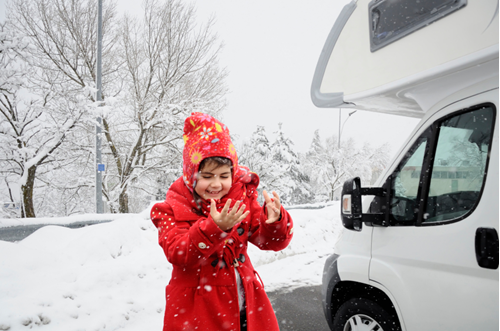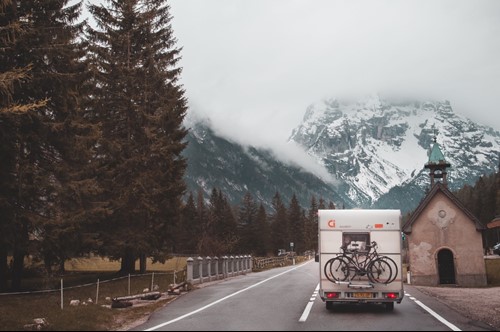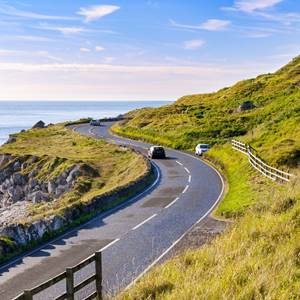Whether you are storing your motorhome this winter or keep on rolling, take these steps to protect your motorhome over winter.
The most dangerous thing about winter is its propensity to drop below freezing. This turns water into ice, which then expands, and can rupture water pipes.
The two words “burst pipes” are enough to strike fear into the minds of any motorhome owner, and especially for the majority of people who don’t pursue the hobby over winter.
Winterising your motorhome for idleness
The most important step to prevent burst pipes is to drain down your motorhome in preparation for winter idleness and storage. Clearing the pipes of all traces of water is the only thing that will eliminate the possibility that your water pipes may burst.
Follow these steps for a smooth draining-down process:
- Drain down your water heater unit.
- Open up your drain down valve and then open up all of the taps.
- Flush the toilet and add antifreeze (at a ratio of 3:1) into the mix as the bowl attempts to refill. Flush it again, and any lingering water should contain a protective amount of antifreeze.
Most handbooks recommend topping up antifreeze levels once per year. So if you haven’t already, there’s no better time than now.

Winterising your motorhome for long-term travel
Frozen pipes are such a danger in idle motorhomes because they are often left unattended and to the full wrath of Mother Nature. But by way of living in your motorhome, the chances of the pipes freezing come down a bit — providing you are keeping warm; using space-heaters and burning propane — but the danger is still very real.
You will still need a level of vigilance about you. And this means taking constant proactive measures to stop the conditions for frozen pipes arising. A good way to do this is to invest in a multi-sensor thermometer. This will help you to monitor the temperature conditions at multiple stops on your motorhome, so you can act accordingly if it looks like the pipes could freeze.
Other steps include:
- Wrapping heat tape around any pipes and hoses for insulation. This is especially important if the pipes are external.
- Keep the area where your water supply connects to the motorhome warm by installing a 40-watt bulb in the rig. It doesn’t sound like much, but it will make a big difference.
- If you expect there might be snowfall, invest in a slide topper. Toppers are ideal for keeping snow and water from accumulating on the roof and entering through loose joints and skylights.

Winter spring-cleaning — for a long planned absence
The great thing about a motorhome is that it doesn’t require any spring cleaning. Why? Because most sensible people do the cleaning in the winter. A deep clean now will not only help to protect your motorhome, it will mean that when spring comes around all you will have to do is start the engine and drive off.
We would recommend starting from the inside:
- Remove all traces of food and wipe down the inside of the fridge and kitchen areas.
- Take all batteries home with you, including the motorhome battery. They should be kept warm and dry for optimal use, and top-up charged every month or so.
- Take any fabrics home with you, too. They might get cold and damp over the winter. Better to keep them dry in the house.
- The winter months are prime time for theft. So remove any valuables, at least from plain sight, to deter any opportunistic criminals.

On the outside, we would recommend:
- Clearing the drain pipes and gutters, and making sure they don’t get clogged with leaves and other debris.
- Give your tyres a good check for punctures, and for general road-worthiness.
- Spray the electrics with a little WD-40, for some extra protection against that auld enemy — water and moisture.
At this point you’re almost done. Almost. A lot of people, after applying the overwintering fluid, tend to forget about the existence of their motorhome until the springtime.
This is a bad idea.
Ideally, you should check up on it periodically, just to make sure everything is alright. Check-ups don’t have to be every week, or even every two weeks, but you should inspect your motorhome a few times over the winter months. Then do the following:
- Take your motorhome for a short drive. This will take the load off the wheels at certain points and help to keep them in a good order.
- Turn the air conditioning on now and again to clear out any humidity.

Whatever you do this winter, remember…
Never underestimate the power of water and the damage it can do over the winter. If you are done for the winter, check up on your motorhome regularly for damage. If you plan on living in it well… look after yourself. Stay vigilant and don’t let it get too cold.
But more importantly, remember to enjoy yourself.
This piece is written by Neil Wright who is the content writer for We Buy Any Motorcaravan. He also has first-hand knowledge of winter life on the road after one (some would say foolish) winter sojourn in Alberta, Canada, and the North-western United States.


